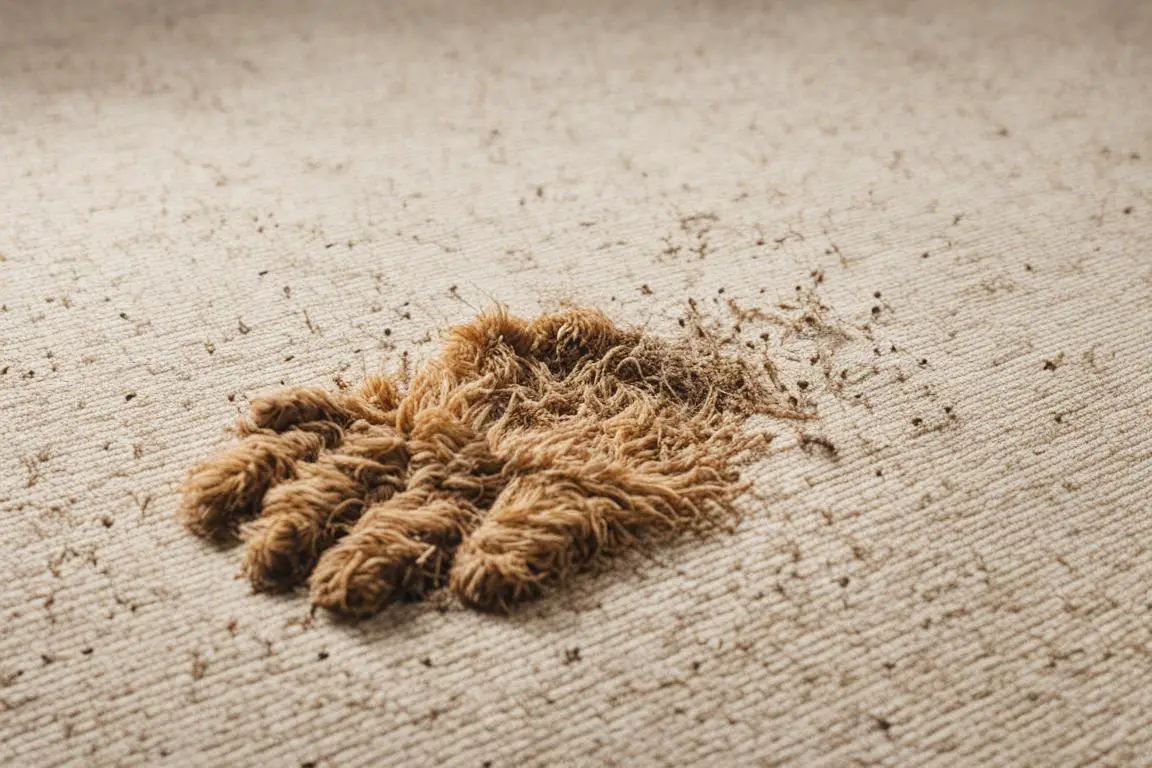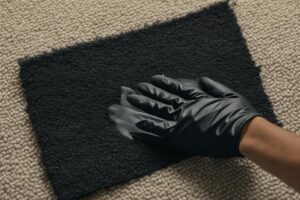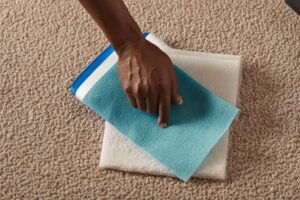Have you ever wondered why your beloved furry friend insists on scratching at the carpet? It can be frustrating to witness your dog engaging in this behavior, but understanding the reasons behind it is the key to finding a solution. Dogs may scratch at the carpet for various reasons, and it’s essential to address the underlying cause to prevent carpet damage and ensure your dog’s well-being.
Key Takeaways:
- Dogs scratch at the carpet due to reasons like boredom, attention-seeking behavior, anxiety, and grooming their nails.
- Some dogs scratch to mark territory, exhibit nesting behavior, or follow their breed instincts.
- Preventing carpet scratching involves providing mental and physical stimulation, redirecting the behavior, and addressing any underlying anxiety or stress issues.
- Trimming your dog’s nails regularly and offering designated scratching areas can help redirect their scratching behavior.
- Excessive carpet scratching may indicate anxiety or stress, and creating a safe and comfortable environment is crucial in addressing the behavior.
Common Reasons for Dog Scratching at Carpet
Dogs may scratch the carpet out of boredom or frustration, using it as a way to alleviate anxiety or seek attention. Some dogs scratch the carpet to groom their nails, relieve discomfort, or remove dirt from their paws. Scratching can also be a form of marking territory and nesting behavior. Certain breeds, such as terriers, have a natural instinct to dig and may exhibit this behavior on carpets. It’s important to determine the specific reason behind a dog’s scratching to address it effectively.
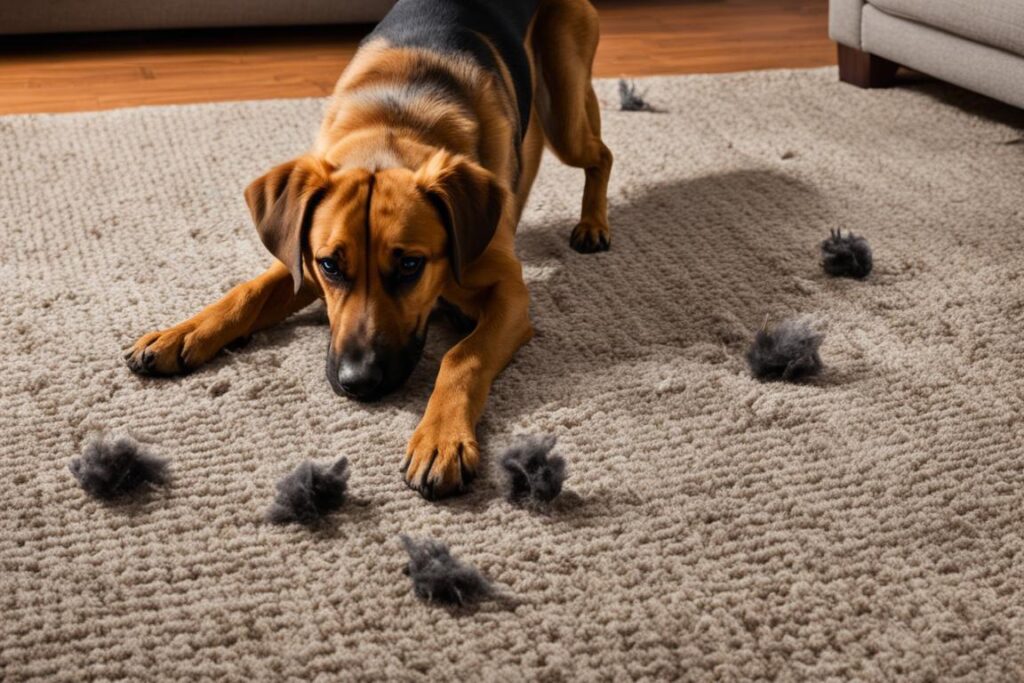
“A dog may scratch the carpet when feeling anxious, bored, or as a way to groom their nails.”
Understanding carpet scratching in dogs and the reasons behind it can help pet owners find appropriate solutions and prevent excessive damage to their carpets. By identifying the underlying causes and implementing the right strategies, you can redirect your dog’s behavior and create a harmonious living environment.
Next, we will explore some helpful tips for preventing dogs from scratching carpet.
Tips for Preventing Dogs from Scratching Carpet
Preventing dogs from scratching the carpet requires a proactive approach that focuses on providing mental and physical stimulation to combat boredom. By understanding the underlying reasons for their scratching behavior, you can implement effective strategies to redirect their attention and protect your carpets. Here are some tips to help you prevent dogs from scratching the carpet:
1. Enrichment Activities
Engage your dog in enriching activities that stimulate their senses and keep them mentally and physically engaged. Puzzles, interactive toys, and treat-dispensing games are excellent options that can reduce stress and frustration, discouraging them from scratching the carpet.
2. Use Barriers
Prevent access to specific areas where your dog tends to scratch the carpet excessively. Baby gates or puppy playpens can be used to block off these areas, ensuring that your dog focuses their attention elsewhere, away from the carpet.
3. Provide Alternatives
Offer designated scratching areas such as scratchboards or digging pits. These alternatives provide a suitable outlet for your dog’s natural instincts and allow them to satisfy their scratching needs without damaging your carpets. Encourage your dog to use these alternatives by rewarding and praising them when they do.
4. Regular Nail Trimming
Keep your dog’s nails properly trimmed to minimize the impact on your carpets. Overgrown nails can cause discomfort and increase the likelihood of scratching. Regular nail trimming not only prevents damage to your carpets but also contributes to your dog’s overall comfort and well-being.
5. Positive Reinforcement Training
Train your dog using positive reinforcement techniques to redirect their scratching behavior. Utilize cues like “leave it” to discourage them from scratching the carpet and provide them with alternative toys or chews that they can focus their attention on. Reward them with treats and praise when they engage in appropriate scratching behaviors.
By implementing these tips, you can effectively prevent dogs from scratching the carpet, preserving the beauty of your flooring while ensuring your furry friend remains happy and mentally stimulated. Remember to be patient and consistent in your approach, offering positive reinforcement to encourage desired behaviors and discourage unwanted scratching habits.

Stay tuned for the next section, where we address anxiety and stress-related carpet scratching behaviors in dogs.
Addressing Anxiety and Stress-Related Carpet Scratching
Excessive scratching on carpets can be a sign of anxiety or stress in dogs. Identifying the triggers causing anxiety, such as loud noises or unfamiliar situations, is crucial in addressing the behavior. Creating a safe and comfortable environment for the dog, using calming aids like pheromone diffusers or anxiety wraps, and providing plenty of exercise and mental stimulation can help reduce anxiety and prevent obsessive carpet scratching. Consulting with a professional dog behaviorist may be beneficial for dogs experiencing severe anxiety or stress-related scratching.
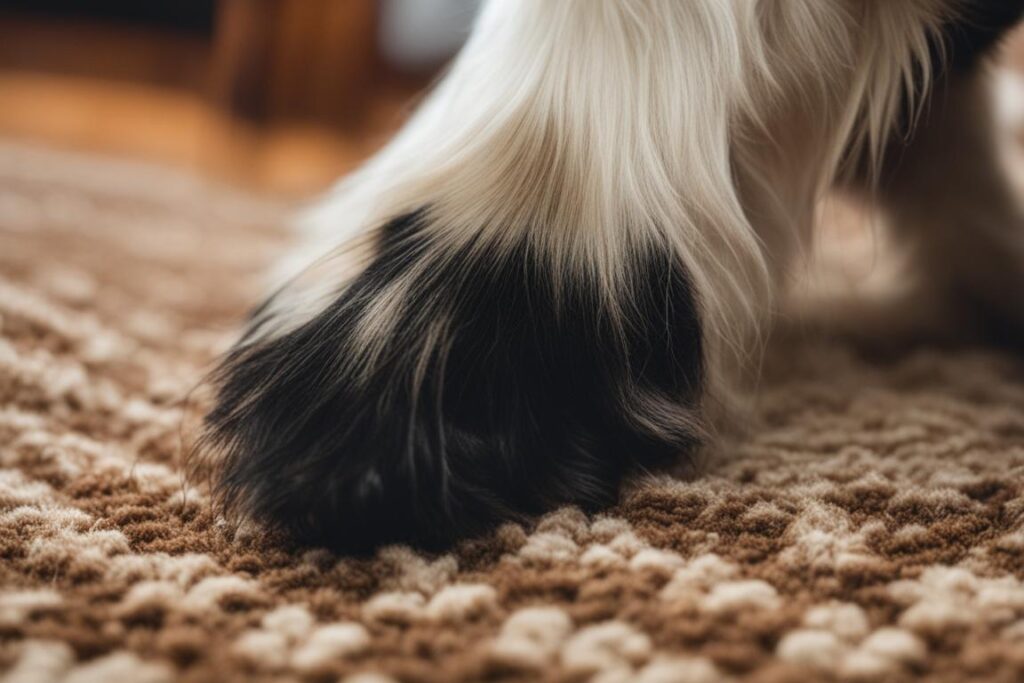
To effectively address anxiety and stress-related carpet scratching behavior, it’s important to understand the underlying causes and implement appropriate strategies. Here are some key steps to consider:
- Identify triggers: Observe your dog’s behavior and identify specific situations or stimuli that trigger anxiety or stress. This can include loud noises, separation, or changes in the environment.
- Create a safe environment: Provide a safe and comfortable space for your dog where they can retreat to when they feel anxious. This can be a designated area with their bed, toys, and familiar scents.
- Calming aids: Consider using calming aids such as pheromone diffusers, anxiety wraps, or herbal remedies to help reduce anxiety levels in your dog. These aids can provide a sense of security and relaxation.
- Exercise and mental stimulation: Engage your dog in regular physical exercise and provide mental stimulation through interactive toys, puzzles, or training sessions. This helps to redirect their focus and energy away from destructive behaviors like carpet scratching.
- Professional guidance: If your dog’s anxiety or stress-related scratching persists or worsens, consider consulting with a professional dog behaviorist. They can provide personalized guidance and develop a behavior modification plan tailored to your dog’s specific needs.
Remember, addressing anxiety and stress-related carpet scratching requires patience and consistency. By implementing these strategies and seeking professional guidance when needed, you can help your dog find relief from anxiety and prevent further damage to your carpets.
Tips for Addressing Anxiety-Related Carpet Scratching:
- Provide a safe and comfortable environment.
- Use calming aids like pheromone diffusers or anxiety wraps.
- Engage your dog in regular exercise and mental stimulation.
- Consult with a professional dog behaviorist for personalized guidance.
| Causes of Anxiety and Stress-Related Carpet Scratching | Preventive Measures |
|---|---|
| Loud noises or unfamiliar situations | Creating a safe environment, using calming aids |
| Separation anxiety | Gradual desensitization, providing interactive toys and puzzles |
| Changes in the environment | Keeping a consistent routine, providing a designated space for the dog |
Conclusion
Understanding why dogs scratch at the carpet is essential in preventing damage and addressing this behavior effectively. By providing dogs with mental and physical stimulation, redirecting their scratching behavior, and addressing any underlying anxiety or stress issues, pet owners can overcome this quirky habit. Not only does this prevent carpet damage, but it also contributes to the overall well-being and happiness of our furry friends.
To address dog scratching behavior, pet owners can implement various strategies. Engaging dogs in fun and interactive activities, such as puzzles and games, helps combat boredom and reduce the need for carpet scratching. Creating designated scratching areas, such as scratchboards or digging pits, allows dogs to satisfy their need to scratch while protecting the carpet. Regular nail trimming is also crucial to prevent dogs from using the carpet as a means to groom their nails.
In instances where anxiety or stress is the underlying cause of carpet scratching, it is important to identify and address the triggers that induce these emotions in dogs. Providing a calming environment, utilizing tools like pheromone diffusers or anxiety wraps, and ensuring ample exercise and mental stimulation can help alleviate anxiety and reduce excessive scratching. Consulting with a professional dog behaviorist may be beneficial for severe cases.
By taking proactive measures and understanding our canine companions, we can prevent carpet damage caused by scratching and promote a harmonious home environment for both pets and pet owners alike.
FAQ
Why do dogs scratch at carpet?
Dogs may scratch at the carpet for various reasons, including boredom, attention-seeking behavior, anxiety, grooming their nails, marking territory, nesting, and breed instincts.
How can I prevent dogs from scratching the carpet?
To prevent dogs from scratching the carpet, it is essential to provide them with mental and physical stimulation, block access to specific areas, trim their nails regularly, provide designated scratching areas, and use positive reinforcement training.
What should I do if my dog excessively scratches the carpet?
Excessive scratching on carpets can be a sign of anxiety or stress in dogs. Identifying triggers, creating a safe environment, using calming aids, providing exercise and mental stimulation, and consulting with a professional behaviorist can help address the behavior.
How can I understand my dog’s scratching behavior on carpet?
Understanding the reasons behind a dog’s scratching behavior is crucial. Observing their behavior, considering possible triggers, and consulting with a professional can help comprehend and address the behavior effectively.
